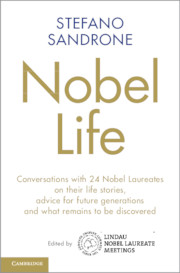 Nobel Life
Nobel Life Book contents
- Nobel Life
- Nobel Life
- Copyright page
- Dedication
- Contents
- Foreword
- Preface
- 1 The Periodic Table
- 2 Eureka and Disney World
- 3 Flying High
- 4 I’ll Show You What a Woman Can Do
- 5 Toys’ Stories
- 6 Clarity
- 7 Mentoring
- 8 A Stroke of Colour
- 9 Impact Factors
- 10 Know Thyself
- 11 Memory and Vision
- 12 Words and People
- 13 Christmas and Carol
- 14 Rocket Science
- 15 The Big Bang Practice
- 16 Houston, We Have a Solution and Many Questions
- 17 À la Recherche of Space and Time
- 18 Leadership and Society
- 19 Of Kings and Cabbages
- 20 Foreword to the Future
- Acknowledgements
- Appendix: List of Nobel Laureates
- Credits
- Index
1 - The Periodic Table
Published online by Cambridge University Press: 03 June 2021
- Nobel Life
- Nobel Life
- Copyright page
- Dedication
- Contents
- Foreword
- Preface
- 1 The Periodic Table
- 2 Eureka and Disney World
- 3 Flying High
- 4 I’ll Show You What a Woman Can Do
- 5 Toys’ Stories
- 6 Clarity
- 7 Mentoring
- 8 A Stroke of Colour
- 9 Impact Factors
- 10 Know Thyself
- 11 Memory and Vision
- 12 Words and People
- 13 Christmas and Carol
- 14 Rocket Science
- 15 The Big Bang Practice
- 16 Houston, We Have a Solution and Many Questions
- 17 À la Recherche of Space and Time
- 18 Leadership and Society
- 19 Of Kings and Cabbages
- 20 Foreword to the Future
- Acknowledgements
- Appendix: List of Nobel Laureates
- Credits
- Index
Summary
Professor Roald Hoffmann, during World War II, as a child, you lived in a ghetto and a labour camp. Then, you hid for fifteen months in the attic and the storeroom of a schoolhouse. You were there with your mum and some of your family, and unfortunately only a few of those who weren’t with you survived. What are your memories of those tough months?
- Type
- Chapter
- Information
- Nobel LifeConversations with 24 Nobel Laureates on their Life Stories, Advice for Future Generations and What Remains to be Discovered, pp. 1 - 8Publisher: Cambridge University PressPrint publication year: 2021
